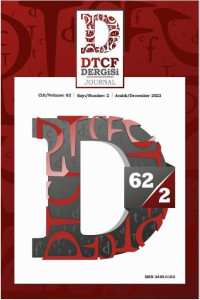Abstract
Onomatopeic word is the way that the sounds in nature are put into words within the possibilities of a language and in the closest way to those sounds. According to the theory of onomatopeic, which is one of the theories put forward about the birth of languages, languages emerged as a result of people imitating the sounds they heard in nature. The main premise of those who defend this theory is that almost all of the languages spoken in the world have more or less onomatopeic words. However, although there are onomatopeic words in every language, these words do not occupy a large place in the vocabulary of languages. Turkish, on the other hand, is one of the richest languages in the world in terms of the number of onomatopeic words it contains compared to its vocabulary. The fact that there are many onomatopeic words in every dialect of Turkish and in the dialects of these dialects proves this situation. In literary works written, onomatopeic words are frequently used to describe a situation, existence or movement in a more effective and permanent way in the spoken language. These words, which are imitations of the sounds in nature, have taken their place not only in the standard spoken language but also in the dialects, by being used continuously in the centuries-old historical development process of Turkish, by diversifying their usage patterns and preserving their vitality in this way. In this study, the aim is to examine and evaluate the onomatopeic words that meet a situation, presence or movement in Van dialect in terms of meaning, sound and shape features.
References
- Atalay, B. (2013). Divânü Lûgat-it Türk Dizini. Ankara: Türk Dil Kurumu Yayınları.
- Banguoğlu, T. (2015). Türkçenin Grameri. Ankara: Türk Dil Kurumu Yayınları.
- Clauson, S. G. (1972). An Etymological Dictionary of Pre-Thirteenth-Century Turkish. Oxford: Clarendon Press.
- Eraslan, K. (2012). Eski Uygur Türkçesi Grameri. Ankara: Türk Dil Kurumu Yayınları.
- Ercilasun, A. B. ve Akkoyunlu Z. (2015). Dîvânu Lugâti’t-Türk (Giriş-Metin-Çeviri-Notlar-Dizin). Ankara: Türk Dil Kurumu Yayınları.
- Eren, H. (1953). Onomatopée'lere Ait Notlar. Erişim Tarihi: 01.11.2022, https://dergipark.org.tr/tr/download/article-file/172702
- Ergin, M. (2003). Türk Dil Bilgisi. İstanbul: Bayrak Basım Yayın Tanıtım.
- Gabain, A. V. (2007). Eski Türkçenin Grameri (M. Akalın, Çev.). Ankara: Türk Dil Kurumu Yayınları.
- Gülensoy, T. (2011). Köken Bilgisi Sözlüğü. Ankara: Türk Dil Kurumu Yayınları.
- Kâşgarlı Mahmud. (2013). Divânü Lûgat-it Türk (B. Atalay, Çev.). Ankara: Türk Dil Kurumu Yayınları.
- Korkmaz, Z. (2014). Türkiye Türkçesi Grameri (Şekil Bilgisi) (4. baskı). Ankara: Türk Dil Kurumu Yayınları.
- Sarıca, B. (2006). Van Gölü Çevresi Ağızları Sözlüğü. Ankara: Atlas Yayınları.
- Zülfikar, H. (1995). Türkçede Ses Yansımalı Kelimeler. Ankara: Türk Dil Kurumu Yayınları.
Abstract
Yansıma sözcük, doğadaki seslerin bir dilin imkânları dâhilinde ve o seslere en yakın şekilde sözcüklere dökülme biçimidir. Dillerin doğuşuyla ilgili ileri sürülen teorilerden biri olan yansıma teorisine göre diller, insanların doğada duydukları sesleri taklit etmesi sonucunda ortaya çıkmıştır. Bu teoriyi savunanların temel dayanak noktası da dünyada konuşulan dillerin hemen hemen hepsinde az ya da çok yansıma sözcük bulunmasıdır. Fakat her dilde yansıma sözcük bulunmasına rağmen bu kelimeler, dillerin sözcük dağarcığında çok büyük bir yer tutmamaktadır. Türkçe ise sahip olduğu söz varlığına oranla bünyesinde bulundurduğu yansıma sözcük sayısı bakımından dünyanın en zengin dillerinden biridir. Türkçenin her lehçesinde ve bu lehçelerin ağızlarında çok sayıda yansıma sözcük bulunması da bu durumu kanıtlar niteliktedir. Kaleme alınan edebi eserlerde, konuşma dilinde bir durumu, varlığı ya da hareketi daha etkili, kalıcı bir şekilde anlatmak için yansıma sözcükler sıklıkla kullanılmaktadır. Doğadaki seslerin taklidi olan bu sözcükler, Türkçenin yüzlerce yıllık tarihi gelişim sürecinde sürekli kullanılarak, kullanım şekilleri çeşitlenerek ve bu şekilde canlılıklarını koruyarak bugün sadece standart konuşma dilinde değil ağızlarda da yerlerini almışlardır. Bu çalışmada da amaç, Van ağzında bir durumu, varlığı ya da hareketi karşılayan yansıma sözcükleri anlam, ses ve şekil özellikleri açısından inceleyip değerlendirmektir.
References
- Atalay, B. (2013). Divânü Lûgat-it Türk Dizini. Ankara: Türk Dil Kurumu Yayınları.
- Banguoğlu, T. (2015). Türkçenin Grameri. Ankara: Türk Dil Kurumu Yayınları.
- Clauson, S. G. (1972). An Etymological Dictionary of Pre-Thirteenth-Century Turkish. Oxford: Clarendon Press.
- Eraslan, K. (2012). Eski Uygur Türkçesi Grameri. Ankara: Türk Dil Kurumu Yayınları.
- Ercilasun, A. B. ve Akkoyunlu Z. (2015). Dîvânu Lugâti’t-Türk (Giriş-Metin-Çeviri-Notlar-Dizin). Ankara: Türk Dil Kurumu Yayınları.
- Eren, H. (1953). Onomatopée'lere Ait Notlar. Erişim Tarihi: 01.11.2022, https://dergipark.org.tr/tr/download/article-file/172702
- Ergin, M. (2003). Türk Dil Bilgisi. İstanbul: Bayrak Basım Yayın Tanıtım.
- Gabain, A. V. (2007). Eski Türkçenin Grameri (M. Akalın, Çev.). Ankara: Türk Dil Kurumu Yayınları.
- Gülensoy, T. (2011). Köken Bilgisi Sözlüğü. Ankara: Türk Dil Kurumu Yayınları.
- Kâşgarlı Mahmud. (2013). Divânü Lûgat-it Türk (B. Atalay, Çev.). Ankara: Türk Dil Kurumu Yayınları.
- Korkmaz, Z. (2014). Türkiye Türkçesi Grameri (Şekil Bilgisi) (4. baskı). Ankara: Türk Dil Kurumu Yayınları.
- Sarıca, B. (2006). Van Gölü Çevresi Ağızları Sözlüğü. Ankara: Atlas Yayınları.
- Zülfikar, H. (1995). Türkçede Ses Yansımalı Kelimeler. Ankara: Türk Dil Kurumu Yayınları.
Details
| Primary Language | Turkish |
|---|---|
| Subjects | Language Studies |
| Journal Section | Research Article |
| Authors | |
| Early Pub Date | December 15, 2022 |
| Publication Date | December 20, 2022 |
| Submission Date | November 16, 2022 |
| Published in Issue | Year 2022 Volume: 62 Issue: 2 |
Cited By
Van Ağzında Kullanılan İkilemeler Üzerine Bir Değerlendirme
Eskişehir Osmangazi Üniversitesi Sosyal Bilimler Dergisi
https://doi.org/10.17494/ogusbd.1498231
Van Ağzından Derleme Sözlüğü'ne Katkılar
Çekmece Sosyal Bilimler Dergisi
https://doi.org/10.55483/cekmece.1523257
Ankara University Journal of the Faculty of Languages and History-Geography is licensed under Creative Commons Attribution 4.0 International (CC BY 4.0).


